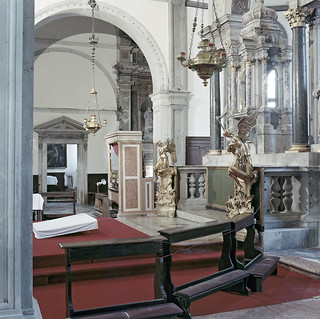I had about forty-five minutes inside the church of Santa Maria Formosa before the light went. I shot eight frames (I think), of which this is the best – though that's not saying much. What was I looking at? I remember noting the following (in no particular order):
1) The light in the window on the right shining through the columns of the altar.
2) The red of the carpet, the green on the front of the altar and the mottled, pinkish organ booth. If a space is not articulated by contrasts in the distribution of colour, then there’s no point in using colour film.
3) The two prominent hanging lamps, which represented a problem that I was unable to solve to my complete satisfaction (so that their current positions within the frame were a compromise).
4) The golden angels, and in particular the fact that one of them is being ‘stabbed’ in the head by a partially-visible statue on the altar behind.
5) The position of the column at the left in the foreground relative to the pediment of the doorway in the background.
6) The four objects covered in white cloths on the left side of the frame. (What exactly is the tilted object on the floor? I don’t know and it bothers me.)
7) The difference in the source and intensity (and hence the colour) of the light through the doorway on the left. I was less aware of the patch of cold light at the bottom right and I didn’t notice the colour shift in the column on the left at all. The latter effects are stronger on the film than they appeared to the naked eye.
8) The red thread running around the benches, which is a more delicate but more absolute boundary of the space within than the benches themselves. And it is somehow important that the thread is red. (N.B. The thread may not be visible in the miniatruzed version above.)
9) The figure in the painting through the door on the left. It was important to show all of it. (The figure is also difficult to see in the version here.)
The list could be extended – but never to the point where it includes everything in the frame.





